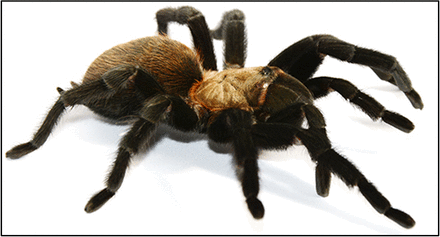Tarantula coordination disintegrates in heat

Scuttling across the floor, a spider's movements have more in common with robots than you may at first realise. Instead of contracting muscles to extend a limb, spiders inflate their joints with haemolymph to straighten them – in much the same way that hydraulic fluid propels robot limbs. And temperature fluctuations may affect the movements of spiders and robots alike: fluid viscosity can increase dramatically as temperature falls, prompting undergraduate Nick Booster from Pitzer College, USA, to ask whether spider movements are affected by temperature change. 'I've always wanted to study spiders because they use hydraulics', says Anna Ahn from Harvey Mudd College, USA, so when Booster approached Ahn and Steve Adolph with his idea to study the effects of temperature on the arachnid's movements, they jumped at the chance. 'This is a fascinating question', Ahn chuckles, adding, 'We wanted to understand how temperature affects the haemolymph and whether impaired haemolymph movement might influence the spiders' ability to run'.
Choosing to test the athletic abilities of Texas brown tarantulas at temperatures that the animals encounter naturally (15, 24, 31 and 40°C), Booster and Harvey Mudd College undergraduate Frances Su painted white dots at four locations on the arachnids' forelegs and hindlegs before filming the animals as they scampered along a runway. Su recalls that the team had no problems getting the spiders to sprint when startled with a gentle puff of air, although collecting movies with a clear view of at least four strides was more troublesome. 'It was difficult when the spiders didn't run in the right direction', says Su; then Booster spent hours painstakingly digitising the position of the spiders' limbs on the movies to accurately track their movements.
After months of patient analysis, it was clear that the spiders' hydraulic limbs were affected by temperature. Going full out at the lowest temperatures, the spiders could only manage a relatively sedate top speed of 20 cm s−1. But, by the time they had warmed up to 40°C, they were rocketing along at a startling 53 cm s−1. And, instead of increasing their stride length as they speeded up, the animals increased the frequency of each stride from a leisurely 4 strides s−1 at 17°C to an impressive 10 strides s−1 at the highest temperature. But, when the team analysed how the spiders coordinated the extension of their joints along the length of their legs, they found that the animals were becoming more uncoordinated at the highest temperatures: at the lowest temperatures, the spiders managed to extend the third and fifth joints at almost the same instant, but as the temperature increased, their control began to fall apart and the animals had more difficulties coordinating the two joints.
Initially, the team had suspected that the spiders may be hampered at lower temperatures by the increased viscosity of the haemolymph. Instead, the spiders' coordination was restricted at higher temperatures, because there may not be enough time for the haemolymph to flow through the leg and back to initiate the next stride at the spiders' blisteringly fast high temperature stride rate.
'Hydraulic extension may allow spiders to save space and mass in their limb, but it may come at the expense of control', says Ahn. And she adds that the inability of tarantulas to coordinate joint extension at high temperatures may partly explain why, instead of taking advantage of the heat of the day, her local tarantulas emerge at dusk when temperatures are cooler.
More information: "Effect of temperature on leg kinematics in sprinting tarantulas (Aphonopelma hentzi): high speed may limit hydraulic joint actuation." J. Exp. Biol. 218, 977-982. DOI: 10.1242/jeb.111922
Provided by The Company of Biologists

















